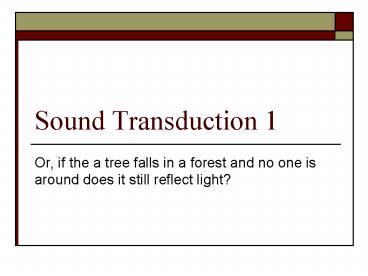Sound Transduction 1 - PowerPoint PPT Presentation
1 / 16
Title:
Sound Transduction 1
Description:
Sound Transduction 1. Or, if the a tree falls in a forest and no one is around ... Theory 1. Stiffen to attenuate sound along the basilar membrane, shear to add ... – PowerPoint PPT presentation
Number of Views:78
Avg rating:3.0/5.0
Title: Sound Transduction 1
1
Sound Transduction 1
- Or, if the a tree falls in a forest and no one is
around does it still reflect light?
2
What is Resonance?
- Resonance
- Characteristic frequency response
- Density Tuning Sharpness
- Hi dense Lo Sharpness
- Size/Cavity
- Breaking Glass Demo
3
The Outer Ear All about resonance
- Pinna
- Immobile cartilage side of head
- Flange
- 3 - 4000 Hz resonance
- Concha
- 1 7000 Hz resonance
- Why such high frequencies?
- Thoughts?
- Directionality
- Finger in folds demo
- Spectral Filter (e.g., Rayker et al., 2004)
- Resonance Frequencies
- 1000 7000 Hz
- Notch Filter
- 700, 3500, 7000, 14000 Hz
4
Outer Ear cont
- Meatus
- Cartilaginous bone
- Density Resonance
- 3000 Hz resonator
- Wax Hair
- Dirt Filter
- Tympanic Membrane
- Elastic Skin stretched across a bony ring
- Stiff cone (2 mm height)
- High Fidelity Transfer
5
Middle Ear The Saga Continues
- The Impedance Problem
- Getting sound to the sensors
- Tympanic Membrane to Oval Window (stapedial
footplate) - Orders of magnitude size difference
- Ossicular chain
- Malleus Incus Stapes Stapedial Footplate
- High density benefits!
6
More middle ear goodness
- Air filled pressure equal to outside
- Eustacian Tube regulation
- High intensity sound response
- Multiple muscles
- Sound attenuators
7
Quick Interruption!
- TLA 1 Hearing Under Water (HUW)
- Why is this important?
- Ingredients
- Sound source (Clicker?)
- Still water (bath, sink, pool)
- Stick your ear, or a friends ear under water
- Make sound in air and under water and listen
with - Out of water ear
- Under water ear
- Questions Which produces the loudest sound? Is
it difficult to determine directionality?
8
Into the Inner Ear
- Major subdivisions of the Bony Labyrinth
- Vestibular Auditory
- Auditory-side Cochlea
- Cochlea
- Cavity within bone, Fluid-filled caverns
- Curls like a snail
9
Life in the Cochlea
- Three major subdivisions
- Scala Vestibuli Largest cavity, filled with
perilymph (e.g., Ricci Fettiplace, 1998) - Positively charged Sodium Ions (Na)
- Scala Media Smallest cavity, filled with
endolymph (e.g., Ricci Fettiplace, 1998) - More positively charged Potassium Calcium Ions
(K, Ca) - Where the action is!!!
- Scala Tympani Mid size cavity, filled with
perilymph - Connected to Scala Vestibuli
10
Scala Media, come get some!
- Organ of Corti
- Organ o Corti contains
- Basilar Membrane (base)
- Tectorial Membrane
- Inner Hair Cells
- Outer Hair Cells
- Hair cells embedded in Bas. Membrane
- Outer Hair Cells contact Tect. Membrane
11
Basilar Membrane
- Properties of the Basilar Membrane
- Apex thin and stiff, Base broad and flexible
- Standing Waves
- Upward spread of masking
- Why do higher Frequencies get masked by lower
frequencies?
12
Why does it matter that the Basilar Membrane
moves?
- Hair cell magic
- Outer Hair Cells
- 12,000 in three rows
- Afferent and Efferent connections
- Attached to muscle fiber
- Inner Hair Cells
- 3,000 in single row
- Afferent connection
- Passive Motion
13
Actual Transduction!
- Wave along Basilar Membrane
- Causes inner hair cell shearing
- Shearing opens channel
- Endolymph in Scala Media attracts perilymph in
Scala Tympani - Charges up Hair cell to cause neural firing
14
What are the outer hair cells doing?
- Outer Hair cells motile embedded in Tectorial
Membrane - Theory 1. Stiffen to attenuate sound along the
basilar membrane, shear to add energy to the
basilar membrane - Theory 2. Stiffen to raise the Tectorial membrane
away from the inner hair cells, shear to lower
the Tectorial membrane and obstruct the inner
hair cells
15
The big picture
- Outer/Middle ear filter and intensify sound
- Inner ear detects sound
- Inner Hair Cell movement along the basilar
membrane - Converts Mechanical energy to Electrical energy
(nerve impulse) - Outer hair cells help modulate movement along the
basilar membrane
16
Questions?






























